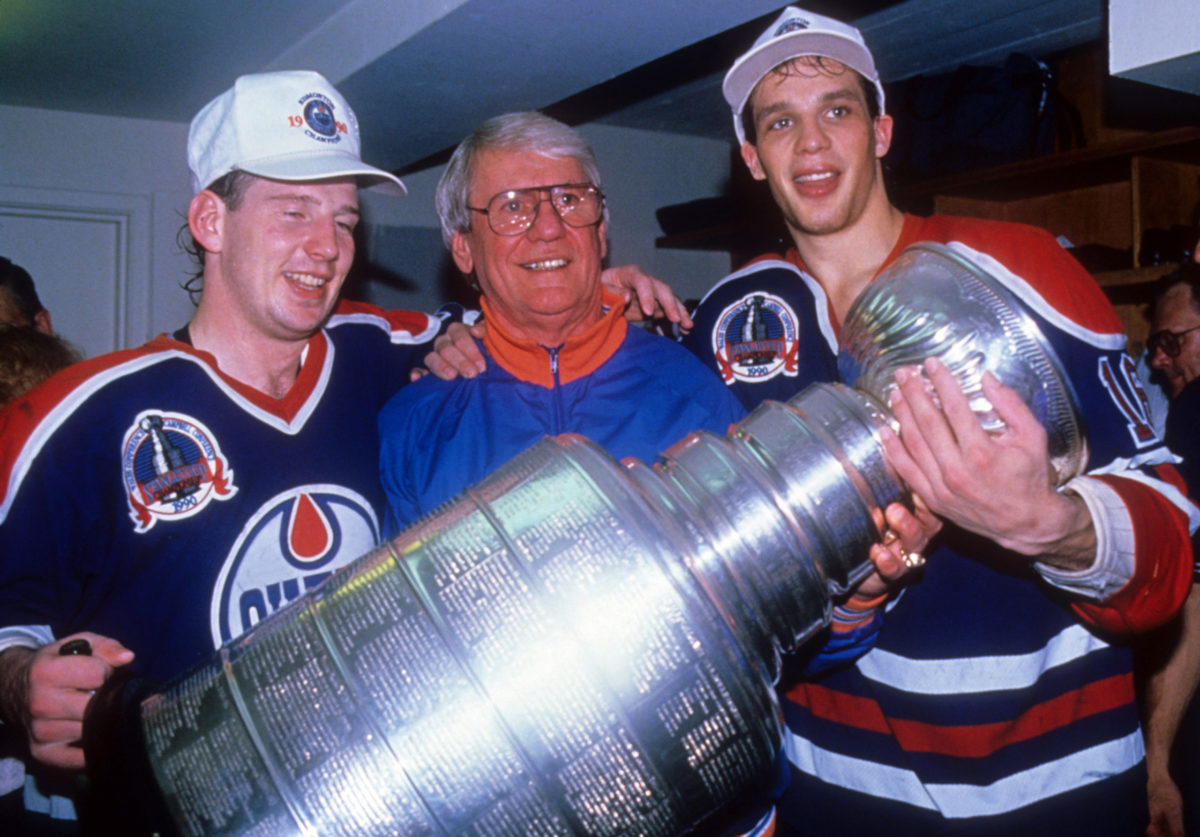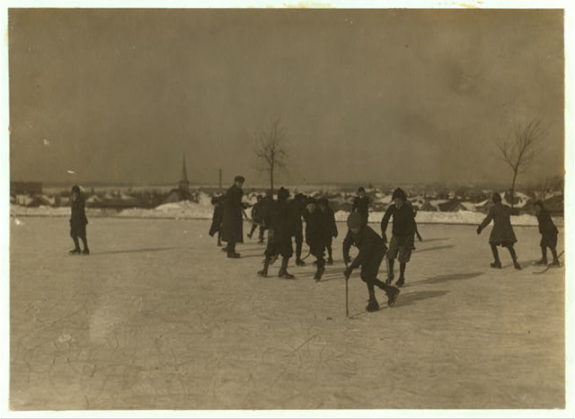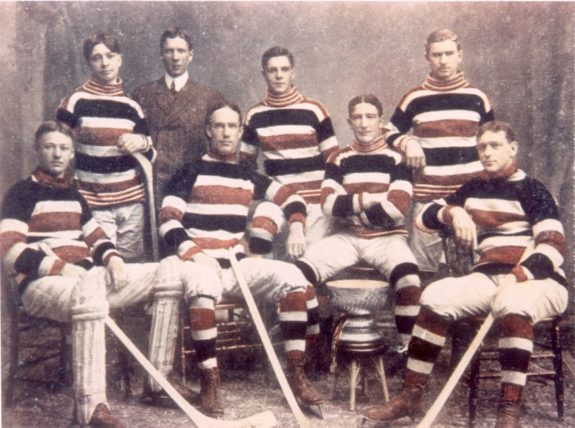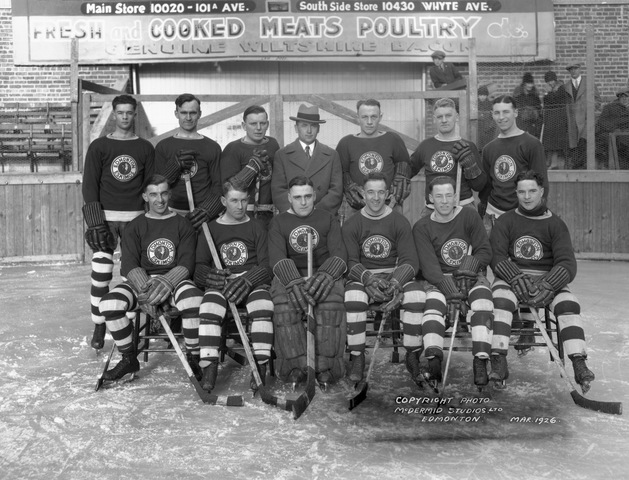The Stanley Cup has a long and storied history, dating back to the late 1800s when it was first donated by Lord Stanley of Preston, the Governor-General of Canada, as an award for Canada’s top-ranking amateur hockey team.

Throughout the years, the city of Edmonton has been lucky enough to have won the Cup five times, with two other trips to the Final, through the Edmonton Oilers. The Oilers first competed for the Cup in 1983, but this wasn’t the first time a team from Edmonton got to play for the Stanley Cup.
Edmonton’s First Crack at the Cup
The first Edmonton team to compete for the Stanley Cup was succinctly named the ‘Edmonton Hockey Club’, challenging for the trophy in December of 1908. Just 14 years earlier, this same Edmonton Hockey Club took part in Edmonton’s first recorded game of hockey, playing on the frozen-over North Saskatchewan river, and losing what was said to be a close game to the North West Mounted Police.

The hockey club would eventually move to an ice rink and in the coming years would build a heated rivalry with their cross-river opponents, the Strathcona Shamrocks. Matches against the Shamrocks were important in growing the game in Alberta, as the secretary of the Shamrocks, R. P. Pettipiece, also served as the editor of the South Edmonton News, dedicating a plethora of articles to the sport and the rivalry between the two teams. Another intriguing person that took part in this rivalry, playing for Edmonton, was William A. Griesbach who would go on to become Mayor of Edmonton and a member of the Senate of Canada.
In 1907, the Edmonton Hockey Club became one of the founding teams of the Alberta Amateur Hockey Association and would go on to become the league champions in that inaugural season. Having won the league, Edmonton was given the opportunity to challenge the Stanley Cup Champion Montreal Wanderers for the trophy. The Wanderers were tough competition, having fended off two previous challengers, but Edmonton had an ace up their sleeve… or so they thought.
For the first game of the two-game series, Edmonton brought in six brand-new players, including future Hockey Hall of Famers Didier Pitre, Tommy Phillips, and Lester Patrick. Unfortunately, things didn’t go as planned for Edmonton and they were thrashed 7-3 by the Wanderers. Their defeat was attributed to a lack of chemistry, leading to two of the ringers being sent home in favour of regular players. This change in personnel seems to have been what the team needed as they took the second game, 7-6, but it wouldn’t be enough, as the Wanderers fended off the Cup challenge with a 13-10 aggregate.
A Second Shot at the Cup
Only two years later, the Edmonton Hockey Club earned themselves another opportunity to play for the Stanley Cup, this time facing off against the Ottawa Senators.

After the 1907-08 season, the AAHA was largely inactive, with Edmonton only participating in exhibition games in order to prepare for future Stanley Cup challenges. In contrast to Edmonton, in March of 1909, the Senators were awarded the Stanley Cup as a reward for finishing atop the Eastern Canada Hockey Association, beating out the defending Cup champion Wanderers.
Starting in 1910, for Ottawa’s defences of the Cup, it was decided by trustees that only players that had skated with their team throughout the year would be able to play in Stanley Cup challenges. This was likely to prevent situations similar to Edmonton’s first Cup run where the majority of their players had never played for the team prior to their challenge.
Coming off of a successful defence of the Stanley Cup against Galt H.C. of the Ontario Professional Hockey League, less than two weeks earlier, the Senators were set to defend the Cup against Edmonton. The series was predicted to be close, but Edmonton just couldn’t measure up to the Senators and lost both games on a 21-11 aggregate.
Adding insult to injury, the team folded later that year.
A New Team and Another Chance for Edmonton
Like a phoenix rising from the ashes, the remnants of the folded Edmonton Hockey Club became a new team. Loosely called the Edmonton Deacons at their inception, the team would later adopt the name Edmonton Eskimos, likely named after Edmonton’s rugby team of the same name.

The Eskimos would play in the AAHA’s Big Four senior league, and upon its dissolution, they would help to found the Western Canada Hockey League. The Eskimos dominated the early WCHL, winning two straight regular-season championships before earning the right to play for the Stanley Cup. At this point in time, there were three top leagues that competed for the Cup, being the NHL, the WCHL, and the Pacific Coast Hockey Association.
Using a new playoff format in 1922-23, the champion of one of these leagues would get a bye to the Stanley Cup Final, while the champions of the other two leagues battled it out in a best of three series. After winning their league, the Eskimos were given a bye to the Final, while the Ottawa Senators defeated the Vancouver Maroons to earn their spot.
The Eskimos and Senators faced off in a two-game series that was very close but was ultimately won by the Senators. Game 1 finished with a score of 2-1 in favour of the Senators, with the decisive tally coming in overtime from future Hall of Famer Cy Denneny. The second game was a brutal affair, with multiple players unable to finish the game due to injury. (from ‘How Ottawa Overcame Numerous Handicaps’. The Globe, 04/03/1928) The situation ended up becoming so dire for the Senators that defender King Clancy was forced to rotate through every single position during the game, even taking a turn in net for two minutes when goaltender Clint Benedict took a penalty. This marked the first and only time that a player played every position in a Stanley Cup Final game. Despite the obstacles in their way, Ottawa managed to hang onto a 1-0 win, and a Stanley Cup victory.
Unfortunately, the Eskimos wouldn’t last much longer after their Cup challenge, with the team folding in 1927 after most of their top talent left the team to play for Boston in the NHL a year earlier. (from ‘A history of Edmonton arena building in photographs, Part 1’, Edmonton Journal, 12/13/2009.)
Looking Back on the Oilers’ Predecessors
When one thinks of hockey in Edmonton, it’s only natural that the first thoughts that come to their head would be of the Oilers and their success throughout the 80s and early 90s, but the Oilers weren’t the only Edmonton team given the opportunity to play for Lord Stanley’s Cup. If not for the Edmonton Hockey Club’s establishment and success, hockey may have never grown to be as popular in Alberta as it is today.
Although the Edmonton Hockey Club and its resurrected counterpart the Eskimos were unable to win the Stanley Cup, they paved the way for the Oilers who finished the job and did what the early Edmonton teams never could.